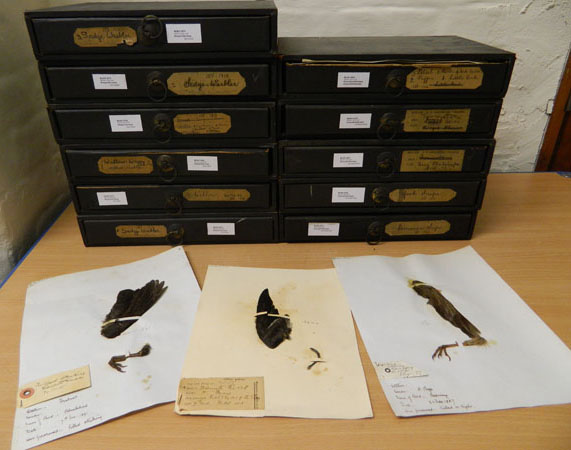Acquired 1916
Barrington’s bird collection
This collection includes approximately 382 mounted birds and 926 study skins as well as 3000 legs and wings of birds involved in collisions with light stations around Ireland.
By Leona McArdleThe “Fassaroe Natural History Collection” was bequeathed to the National Museum of Ireland in October 1916 following the death of R.M. Barrington in 1915. The overall collection contains land and freshwater molluscs, butterflies and some mammals but is mainly known for birds. The bird portion, known as the Barrington bird collection, includes approximately 382 mounted birds and 926 study skins as well as 3000 legs and wings of birds involved in collisions with light stations around Ireland.
Description
The following are register entries for bird specimens donated on 25th October 1916 are as follows:
NH:1916.124: ”141 wooden cases with glass fronts cont. mounted birds; bequeathed to the National Museum by the late R.M. Barrington, Fassaroe, Bray, Co. Wicklow; see also 19-23.1917”
NH:1916.128: "101 black envelope cases cont. legs and wings of birds; bequeathed to the National Museum by the late R.M. Barrington, Fassaroe, Bray, Co. Wicklow; see also 19-23.1917"
NH:1916.129: “69 loose bird skins; bequeathed to the National Museum by the late R.M. Barrington, Fassaroe, Bray, Co. Wicklow; see also 19-23.1917; inc. 1 Harrier (headless), 1 Owl in bad condition and 1 swan; some with broken neck”
Who was R.M. Barrington?
Richard Manliffe Barrington (1849-1915) was born in Fassaroe, near Bray, Co. Wicklow. He was interested in the outdoors and natural science from an early age, publishing his first note on birds at the age of seventeen. He attended Trinity College, gained an M.A. and was called to the Bar, but preferred the outdoor life to law and decided to make his living as a land valuer and farmer. He continued to follow his interest for the natural world carrying out several surveys of areas such as Lough Ree, Lough Erne and Ben Bulben and writing botanical reports, which were published by the Royal Irish Academy.
Barrington was part of an expedition in 1896, led by R.L. Praeger, to Rockall in the Atlantic Ocean, off the north-east coast of Ireland. It became a difficult expedition, due to its remote location and poor weather conditions. Though the party did not actually land on Rockall, they still successfully obtained dredge samples from the shore and recorded three species of sponge that had previously been unknown.
Barrington remained active throughout his career, amassing the substantial collection the museum holds today, as well as becoming a member of the Dublin Naturalists Field Club, Royal Irish Academy, British Ornithologists Union, British Association committee, as well as a Fellow of the Linnaean Society.

Bird migration and lighthouses
The 3000 wing and leg specimens form the backbone of Barrington’s most famous body of work, ‘The Migration of Birds’, a study of migration patterns of birds around the coast of Ireland. Very little was known about the distribution of birds and their migratory routes at this time, and following on from a similar study in Britain, Barrington embarked on a collaboration with keepers of 48 lighthouses and 10 lightships around Ireland that was to last from 1881 until 1897. Barrington differed from the British study by lengthening the sampling timeframe to increase the sample size and yield more satisfactory results and he also wanted to reduce identification inaccuracies.
Barrington asked keepers to record information on all birds killed striking the light stations and to “cut off and label the wing and leg of every common bird which is killed at their station…All species can then be identified with certainty...Rare birds should be sent entire”. Information requested included the date; the number, name and species of bird; direction bird was travelling; the prevailing weather conditions and any other general observations. All costs of this study were borne by Barrington himself.
The results of the study contained detailed lists of every species of bird that collided with lighthouses and lightships at each location, discussed migration routes for the species and when different species arrived in and departed Ireland. Barrington also highlighted several species of birds that were previously unrecorded in Ireland such as the Lesser whitethroat, Lapland bunting, and Woodchat shrike among others. The study remained as the standard work on bird migration until the 1950s when bird observatories were introduced.
Learn more
Examples of mounted taxidermy birds collected by R.M. Barrington can be seen on the first floor of the Natural History Museum. The lighthouse collection and study skins form part of the museum’s reserve collection and are not on display. An online exhibition, ‘Killed Striking’ by artist Karl Grimes explores the Barrington collection.
References
Barrington, Richard M. The migration of birds as observed at Irish lighthouses and lightships. Porter, 1900.
AR Nichols, 1920. ‘Catalogue Barrington Collection Birds.’ National Museum of Ireland.
Foster, John Wilson, and Helena CG Chesney, eds. Nature in Ireland: a scientific and cultural history. McGill-Queen's Press-MQUP, 1998.
Location:
Barrington’s bird collection is located at:
In Storage
Previous artefact:
Next artefact:
Bell from Sheridan’s Foundry, Dublin
